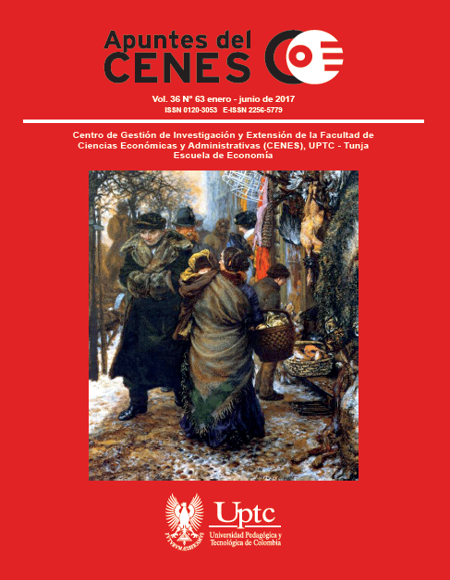Evaluation of the Kuznets Hypothesis for Colombia 1977-2005

Abstract
Inequality in a country can have serious consequences in the economic development and that is why it is important the study of the causes of its variations. Therefore, this document aims to explain how is affected the income inequality by changes in economic growth, population and nominal exchange rate. Following the Kuznets curve hypothesis (1955), a bad indicator of inequality in the short term is necessary to achieve better equality in the long term as an effect of the economic growth. The study is done for Colombia, between 1977 and 2005, with quarterly data. Our results show that the relation between economic growth and income distribution can be explained by the Kuznetshypothesis.
Keywords
income inequality, economic growth, exchange rate, long run, short run
References
- Bahmani-Oskooe, M., Goswami, G., & Mebratu, S. (2006). Black market premium and income distribution. Journal of Development Areas, 39, 17-28. https://doi.org/10.1353/jda.2006.0001 DOI: https://doi.org/10.1353/jda.2006.0001
- Bahmani-Oskooee, M., & Gelan, A. (2008). Kuznets inverted-U hypothesis revisited: a time-series approach using US data. Applied Economics Letters, 15(9), 677-681. https://doi.org/10.1080/13504850600749040 DOI: https://doi.org/10.1080/13504850600749040
- Bourguignon, F., & Morrison, C. (1998). Inequality and development: the role of dualism. Journal of Development Economics, 57. https://doi.org/10.1016/S0304-3878(98)00089-3 DOI: https://doi.org/10.1016/S0304-3878(98)00089-3
- Deininger, K., & Squire, L. (1998). A new data set on measuring income inequality. Journal of Development Economics, 57, 259-289. https://doi.org/10.1016/S0304-3878(98)00099-6 DOI: https://doi.org/10.1016/S0304-3878(98)00099-6
- Gupta, S., Davoodi, H., & Alonso-Terme, R. (1998). Does corruption affect income inequality and poverty? The World Bank Research Observer. https://doi.org/10.5089/9781451849844.001 DOI: https://doi.org/10.2139/ssrn.882360
- Huang, H., Lin, S., & Weng, H. (2006). A semi-parametric partially linear investigation of the Kuznets' hypothesis. Journal of Comparative Economics, 34(3), 634-347. https://doi.org/10.1016/j.jce.2006.06.002 DOI: https://doi.org/10.1016/j.jce.2006.06.002
- Ikemoto, Y., & Uehara, M. (2000). Income Inequality and Kuznets' Hypothesis in Thailand. Income Inequality and Kuznets' Hypothesis in Thailand, 14(4), 421-443. https://doi.org/10.1111/1467-8381.t01-1-00117 DOI: https://doi.org/10.1111/1467-8381.t01-1-00117
- Kuznets, S. (1955). Economic growth and income inequality? American Economic Review, 45, 1-28.
- Lin, S., Suen, Y., Yeh, C., & Huang, H. (2007). A quantile inference of the Kuznets hypothesis. Economic Modelling, 24(4), 559-570. https://doi.org/10.1016/j.econmod.2006.12.005 DOI: https://doi.org/10.1016/j.econmod.2006.12.005
- Williamson, J. (1997). Globalization and Inequality, past and present. The World Bank Research Observer, 12, 117-135. https://doi.org/10.1093/wbro/12.2.117 DOI: https://doi.org/10.1093/wbro/12.2.117
Downloads
Download data is not yet available.
